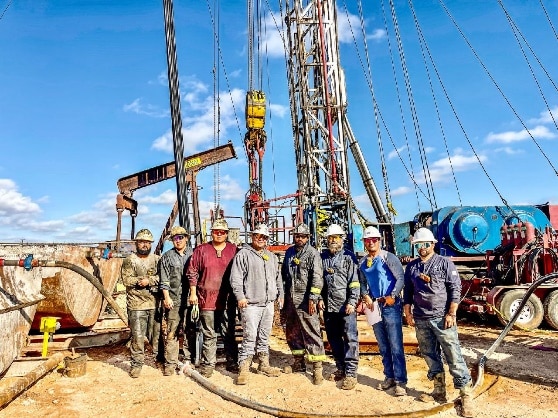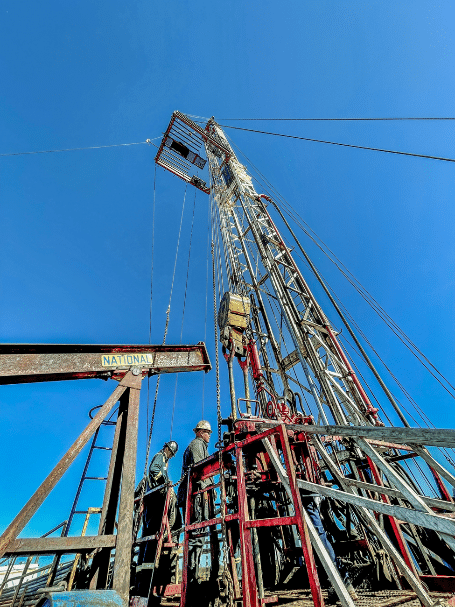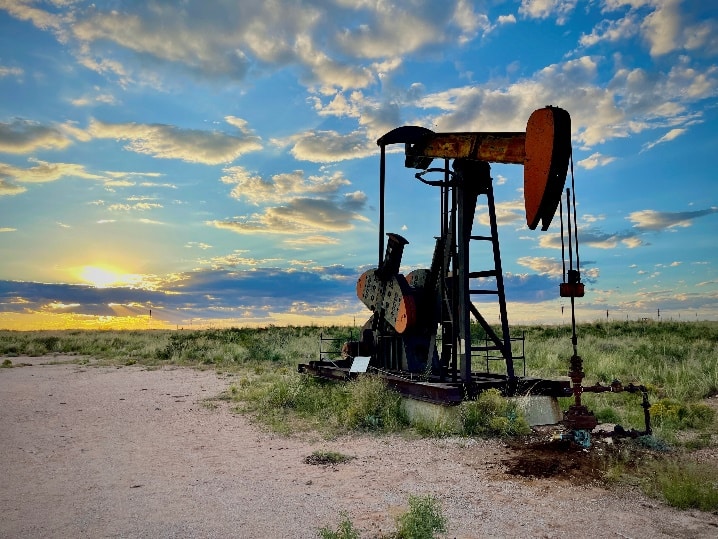 Plugging crew gathers at an orphan well. Courtesy/EMNRD
Plugging crew gathers at an orphan well. Courtesy/EMNRD
 OCD SE NM Inspections Supervisor Gilbert Cordero witnessing methane monitoring at an orphan well. Courtesy/EMNRD
OCD SE NM Inspections Supervisor Gilbert Cordero witnessing methane monitoring at an orphan well. Courtesy/EMNRD
EMNRD News:
SANTA FE — Over the past several months, the New Mexico Energy, Minerals and Natural Resources Department (EMNRD) has made a major positive impact on the environment by beginning to plug orphan oil and gas wells across the state using funds provided by the Bipartisan Infrastructure Law.
Since September 2022, EMNRD’s Oil Conservation Division has prevented more than 46,000 kilograms per year of methane from polluting the atmosphere by plugging 23 orphan wells. That is equivalent to the carbon dioxide emissions from 2.85 million miles per year driven by average gasoline-powered passenger vehicles or the carbon sequestration provided by 1,360 acres of forest in one year.
The pace at which OCD plugs wells will accelerate in 2023 as the division begins expending funds it received last fall from the US Department of the Interior via the Bipartisan Infrastructure Law.
Through the Bipartisan Infrastructure Law, EMNRD received a $25 million grant to address orphaned oil and gas wells on state and private lands in New Mexico. Those funds became available to EMNRD at the beginning of the federal fiscal year Oct. 1, 2022.
The grant required EMNRD to obligate 90% of the funds for plugging and reclamation work by Dec. 31, 2022. The agency met that requirement, with the OCD entering agreements for two contractors to plug nearly 200 orphan wells located on state and private lands, and other contractors to begin remediation and reclamation at other abandoned oil and gas facilities. This work is expected to be ongoing throughout 2023. OCD has until later in 2024 to complete work with initial grant funding.
EMNRD was able comply with the grant’s terms because the OCD began identifying orphan sites across the state before receiving the grant. That process entailed reviewing historic records, undertaking field assessments, ranking wells and facilities based upon their potential risks to the public and the environment, quantifying methane emissions from the wells, and evaluating the usefulness of drone technology to facilitate hazard identification, cleanup, and reclamation.
The federal funding is supplementing the state’s annual investment in its established orphan well plugging and cleanup program. Over the past five fiscal years the OCD has plugged 206 wells utilizing state funding.
For fiscal year 2024, EMNRD is seeking to increase the amount of state funding dedicated to plugging orphan wells by $18,772,400. The increase recognizes OCD’s capacity to manage additional plugging sites. The request also reflects the increased revenue that has been received into the Oil Reclamation Fund from increased oil and gas production and the relatively high sustained price levels. Additionally, several years ago, the state updated its well bonding requirements so more funding would be available for plugging and site restoration when an operating company goes bankrupt.
Over the coming years OCD expects $75 million to $100 million in additional funding to be available through the Bipartisan Infrastructure Law for orphan well plugging and reclamation work. These increased funds will continue to help New Mexico’s oilfield and environmental workers.
Below is a summary of highlights from OCD’s orphan well plugging program:
- The OCD has obligated funds with two plugging contractors to plug 196 orphan wells situated on state and private surface lands.
- Well plugging procedures have been developed along with estimated costs for the established orphans. Proper plugging requires the isolation of oil- and gas-bearing zones and the protection of groundwater.
- Four well plugging rigs and crews are actively operating in southeast New Mexico. Thirteen wells have been successfully plugged since September 2022 with both federal and state monies; with the four rigs, we expect that pace to accelerate.
- The removal and salvage of equipment and materials will be undertaken at every plugged wellsite and facility.
- Preliminary environmental assessments have been completed at 254 sites.
- Environmental cleanups will begin in 2023 at three locations where major historic releases of crude oil and produced water have occurred.
- Pre-plug methane emissions monitoring using state of the art technology has been completed at more than 70 orphan wells with testing scheduled for 126 additional wells. Post plugging confirmation monitoring will be performed at all sites after each well is plugged.
- Drones have gathered high-resolution imagery across approximately 4 square miles of historic oil field operations with another 39 square miles of flights scheduled. These images are being manually reviewed for indications of releases such as distressed vegetation, and improperly closed drilling and production pits. The images will also be processed using “machine learning” to identify and better quantify the extent of the hundreds of miles of idle surface flow lines which require removal.
 Plugging crew with an orphan well. Courtesy/EMNRD
Plugging crew with an orphan well. Courtesy/EMNRD
 Orphan well prior to plugging. Courtesy/EMNRD
Orphan well prior to plugging. Courtesy/EMNRD

